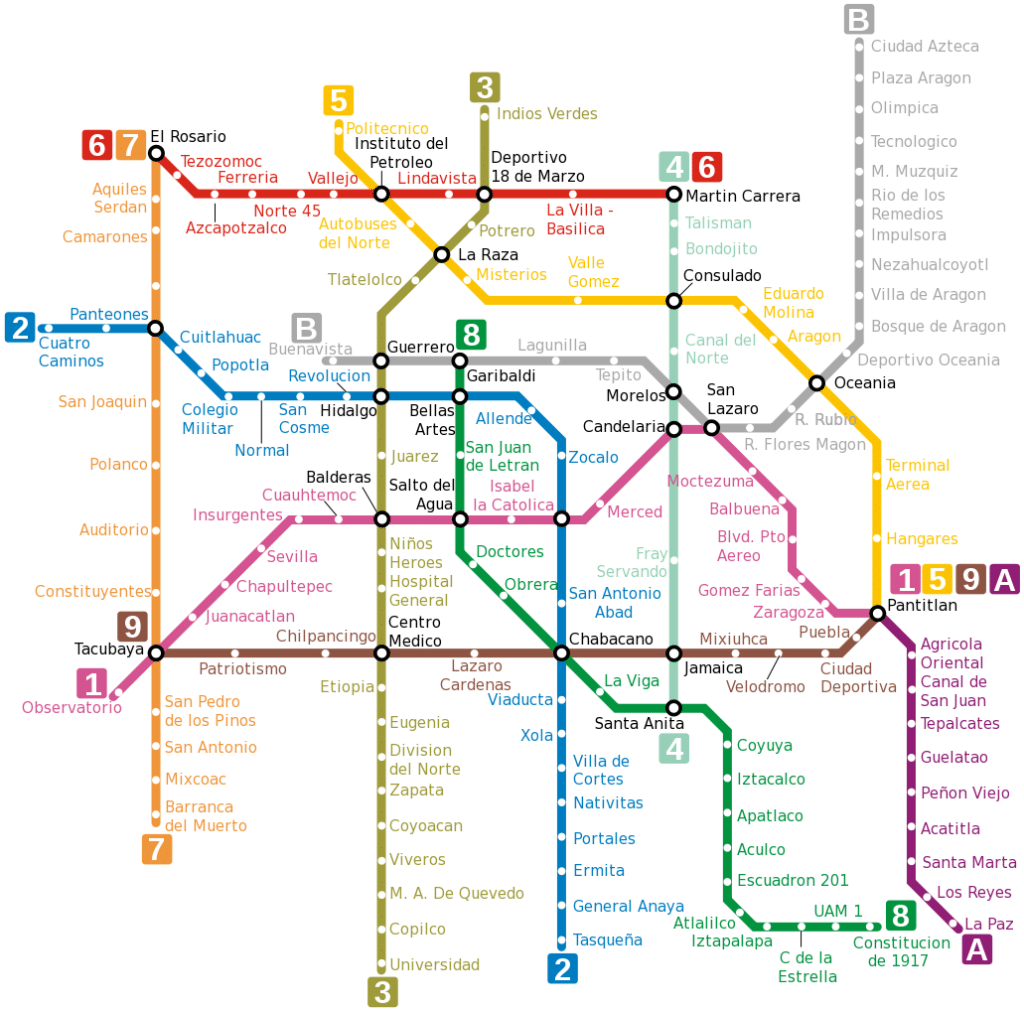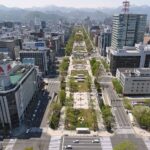Public transportation choices in Mexico City are plentiful and include buses, metros, trolleybuses, trams, and the environmentally friendly Metrobs. The Sistema de Transporte Colectivo, the public transportation company, offers all of these services (STC). The Metro is the most widely used mode of transportation in Mexico City since it offers the quickest and most cost-effective means of transportation. The majority of the city is serviced by 195 stations along 12 lines. With approximately 15,000 buses running throughout the city, buses are another well-liked transportation choice. They operate around-the-clock, seven days a week, and they serve all parts of Mexico City. Private taxis and the Uber service are other options that are more affordable and practical than ordinary taxis.
Basic information about the Metro system in Mexico city
One of the world’s most effective and reasonably priced public transportation systems is the metro system in Mexico City. Every day, millions of commuters utilize it, which runs on 12 lines that cover the entire city. The metro system is renowned for its up-to-date, cozy stations, effective operation, consistent timetable, and reasonably priced prices. It is well-liked by tourists and regarded as one of the world’s safest public transportation networks. Since it first began operating in 1969, the metro system has grown and improved to better serve its users. In general, Mexico City’s metro system is a convenient and reasonably priced means to get around the city.
The lines of the Mexico city subway system
Mexico City is a busy city with a subway system that is one of the best in the world. The Sistema de Transporte Colectivo (STC), which is also called the Mexico City Subway, has 12 lines and 195 stations that serve the city and the areas around it. After the New York Subway, it is the second-largest subway system in North America.
List of the lines
The newest line is Line 12, and the others span from Line 1 to Line 12. Express trains, transfer stations, and wheelchair accessibility are just a few of the features that each line provides. Each line is also color-coded for simple navigation.
The oldest and longest line, Line 1, connects Observatorio in the west with Pantitlán in the east. Some of the most well-known sights, including the Zócalo and the Palacio de Bellas Artes, are located downtown.
Some of the most recognisable neighbourhoods in the city are traversed by the Line 2 as it travels from Tasquea in the south to Cuatro Caminos in the north. Additionally, it offers access to places of interest like Chapultepec Park and the Museo de Antropologia.
The Line 3 travels through the city’s central areas as it travels from Indios Verdes in the northeast to Universidad in the southwest. Additionally, it makes stops at some of the city’s most well-known sights, including the Plaza de la Constitución and the Monumento a la Revolución.
Line 4 travels through some of the most significant commercial and shopping areas of the city as it travels from Martn Carrera in the east to Santa Anita in the west. Additionally, it is a fantastic way to travel to the Universidad Nacional Autónoma de México (UNAM).
Line 5 travels through some of the city’s most storied districts as it travels from Politécnico in the east to Pantitlán in the west. Additionally, it gives visitors access to some of the city’s most well-known sights, including the Monumento a la Revolución and the Palacio de los Deportes.
Line 6 travels through some of the city’s most energetic districts as it travels from El Rosario in the northeast to Martn Carrera in the southwest. Also, you can get to places like the Monumento a la Revolución and the National Anthropology Museum from there.
Some of the city’s most historic neighborhoods are traversed by Line 7 as it travels from El Rosario in the north to Barranca del Muerto in the south. It also lets you get to places like the Palacio de los Deportes and the National Museum of Anthropology, which are both well-known.
Line 8 travels through some of the most significant commercial and shopping areas of the city as it travels from Garibaldi in the east to Constitución de 1917 in the west. Additionally, it offers access to sights like the Plaza de la Constitución and the Ciudad Museum.
Line 9 travels through some of the city’s most recognizable districts as it travels from Tacubaya in the west to Pantitlán in the east. Additionally, it gives visitors access to sights like the Monumento a la Revolución and the Palacio de Bellas Artes.
Line 10 travels through some of the city’s most energetic areas as it travels from Ciudad Azteca in the east to Observatorio in the west. Additionally, it offers access to well-known sights like the Centro Histórico and the Museo de Antropologia.
The Line 11 travels through some of the city’s most storied neighbourhoods as it travels from Zaragoza in the east to Pantitlán in the west. Additionally, it gives visitors access to sights like the Monumento a la Revolución and the Palacio de los Deportes.
The Line 12 travels through some of the city’s most energetic districts as it travels from Mixcoac in the west to Tlhuac in the east. Additionally, it gives visitors access to sights like the Monumento a la Revolución and the Museo de Arte Moderno.
With twelve lines and 195 stops, the Mexico City Subway is a quick and convenient method to navigate the city. The Mexico City Subway is the best means of transportation whether you are a resident or a visitor to the city.
Map of Mexico city Metro 2023 – Free Download in PDF

Anyone who lives in or travels to the city will find the Map of Mexico City Metro 2023 to be a very useful tool. An easy to read map of the city’s metro system, complete with lines, stations, and other areas of interest, is available for free download in PDF format. It’s a useful tool for managing Mexico City’s chaos and will enable you to reach your destination swiftly and effectively. You can easily organize your journey and make sure you don’t miss any of the city’s sights and attractions with the help of the Map of Mexico City Metro 2023.
Public transport tickets in Mexico City – Best types for travelers & actual prices
There are several different public transportation tickets available in Mexico City, which is good news for tourists who want to move around the city swiftly and efficiently. We’ll discuss the many ticket options, their costs, and a tonne of specific information about each one in this article.
The city’s bus system, known as Metrobs, offers the first kind of ticket. A single-use ticket costs 8 pesos and can only be used once; transfers are not permitted. A ticket that can be used more than once costs 16 pesos and lets you ride four times within two hours.
The second kind of ticket is for the Metro, a rapid transit system. A single-use ticket costs 5 pesos, has a single usage and is not transferable. It costs 10 pesos to purchase a multi-riding ticket that allows you to ride four times in two hours.
The third type of ticket is for the light rail line Tren Ligero. A single-use ticket costs 5 pesos, has a single usage, and is not transferable. It costs 10 pesos to purchase a multi-riding ticket that allows you to ride four times in two hours.
The fourth ticket type is the bike-sharing program called Ecobici. It costs 8 pesos for a single-use ticket that can only be used once; transfers are not allowed. For 16 pesos, you can ride four times within two hours with a multiple-riding ticket.
The fifth type of ticket is for the Trolebs, a mode of transportation that follows a specific itinerary. A single-use ticket costs 5 pesos, has a single usage, and is not transferable. It costs 10 pesos to purchase a multi-riding ticket that allows you to ride four times in two hours.
The Metrobs Plus express bus system is the sixth and final type of ticket. A 12-peso single-use ticket can only be used once and cannot be transferred. A multiple-use ticket costs 24 pesos and entitles the holder to four rides within two hours.
You now know the six various categories of public transportation tickets available in Mexico City, each with a unique pricing and set of guidelines. Make sure you have the appropriate ticket for your needs whether you are traveling for work or pleasure.
Summary of fares for public transport in Mexico City
- Metrobs – 8 pesos single-use, 16 pesos multiple-use (four rides within two hours)
- Metro – 5 pesos single-use, 10 pesos multiple-use (four rides within two hours)
- Tren Ligero – 5 pesos single-use, 10 pesos multiple-use (four rides within two hours)
- Ecobici – 8 pesos single-use, 16 pesos multiple-use (four rides within two hours)
- Trolebs – 5 pesos single-use, 10 pesos multiple-use (four rides within two hours)
- Metrobs Plus – 12 pesos single-use, 24 pesos multiple-use (four rides within two hours)
TIMETABLES & SCHEDULES OF MEXICO CITY METRO SYSTEM
The Mexico City Metro system operates every day of the week from around 5 am to midnight. It is one of the largest and most efficient public transportation systems in the world, with over 200 stations spanning over 200 km of the metropolitan area. The metro is broken down into 12 lines and the frequency of trains varies from every 3-5 minutes during peak hours, and every 10-20 minutes during off-peak hours.
WHAT ARE OTHER OPTIONS FOR PUBLIC TRANSPORTATION IN MEXICO CITY?
Mexico City is a bustling metropolitan area with a population of over 21 million people, making it the largest city in all of the Americas. It’s no surprise then that the demand for public transportation is constantly high. Fortunately, Mexico City offers a variety of other public transportation options besides the metro, giving residents and visitors alike a multitude of choices for getting around the city.
One of the most popular options for public transportation in Mexico City is the bus. There are several large bus companies, including RTP, Turistar, and Estrella Roja, that provide transportation throughout the city. Buses are often the most reliable and cost-effective method of transportation in Mexico City, as they have an extensive network of routes and are relatively cheap.
Mexico City also has an extensive network of taxis, and they are a great option for getting around the city. Taxis are usually the quickest way to get from one place to another, and they can be hailed from the street or booked online.
In addition to buses and taxis, Mexico City has a number of other public transportation options. The Metrobús is a bus rapid transit system that provides a fast, efficient way to get around the city. Mexico City also has a light rail system called Tren Ligero, which is similar to the Metrobús but is more affordable.
Mexico City’s public transportation system also includes a popular bicycle-sharing program called Ecobici. The program has over 100 stations located throughout the city, and it is a great way to get around and explore the city.
Finally, Mexico City also has a number of private transportation services, such as Uber, Cabify, and Didi, that provide convenient and reliable rides. These services are often the most expensive option for getting around the city, but they can be a great way to get from one place to another quickly and comfortably.
Overall, Mexico City offers a variety of public transportation options for getting around the city, from buses and taxis to light rail and bicycle-sharing programs. No matter what your budget or preference may be, there are plenty of choices for getting around the city.
HOW TO GET FROM Benito Juarez International Airport (MEX) TO THE CITY CENTER WITH PUBLIC TRANSPORT?
Travelling to a new city can be intimidating, especially if you don’t know how to get from the airport to the city center. But don’t worry – with the right information, getting to your destination is easy. Here’s how to get from Benito Juarez International Airport to the city center with public transportation.
First, you’ll need to find out which public transport services are available from the airport. Benito Juarez International Airport has a variety of options, including bus, train, and taxi. If you’d like to use the most cost-effective option, the bus is probably your best bet. The airport has a dedicated bus stop located outside the terminal building, and there are services that run directly to the city center and other key destinations. Depending on your route, it should take no more than 30 minutes to get to your destination.
If you’d prefer to take the train, there is a dedicated rail station located at the airport. Trains run regularly to the city center, and the journey should take no more than 15-20 minutes. If you’d like to take a taxi, there are several companies operating at the airport. Taxis are more expensive than public transport, but they are a convenient option if you’re traveling with a lot of luggage.
Once you’ve arrived at the city center, there are several other public transport options available, including buses, trams and metro systems. Depending on where you’re heading, you may be able to use one of these services to get to your destination. Getting from Benito Juarez International Airport to the city center with public transportation is easy and convenient. Whether you choose to take the bus, train or taxi, you’ll be at your destination in no time.
What kind of sightseeing do you have to see if you visit the Mexico city for THE first time?
Known for its vibrant culture, rich history, and amazing cuisine, Mexico City is a must-visit destination for travelers looking to explore a unique and diverse city. With so much to do and explore, it can be difficult to decide what attractions to prioritize, so here are some of the top attractions to visit while in Mexico City.
The Historic Center of Mexico City is a must-see, and home to some of the city’s oldest and most iconic landmarks. The area boasts centuries-old architecture, cathedrals, and plazas, including the Zocalo, which is the largest public plaza in Latin America. Other highlights include the Palacio Nacional, the Metropolitan Cathedral, and the Templo Mayor Aztec archaeological site.
The Frida Kahlo Museum, or Casa Azul, is another top attraction in Mexico City. Located in the neighborhood of Coyoacan, the museum houses original works of art, personal items, and photographs of the iconic Mexican painter. Visitors can explore Frida Kahlo’s home and learn about her life and art.
If you’re looking for a fun and unique way to experience Mexico City, a visit to the Xochimilco canals is a must. This ancient system of canals offers a unique perspective on the city and its surroundings. Visitors can take a ride on a colorful trajinera, or gondola, and explore the canals while enjoying traditional Mariachi music.
Mexico City is also home to many impressive cultural venues, including the National Museum of Anthropology, which houses the world’s largest collection of ancient Mexican artifacts. From Aztec and Olmec sculptures to Mayan artifacts, the museum offers a fascinating look into the city’s history and culture.
Finally, the Chapultepec Park is the largest public park in all of Latin America, and a great place to spend a day. The park features several attractions, such as the National Museum of History, the National Museum of Modern Art, and the Chapultepec Zoo, all of which makes for an enjoyable and educational visit.
Mexico City is an incredible destination to explore, and there’s something for everyone to enjoy. Whether you’re looking for culture and history or fun and entertainment, there’s no shortage of attractions to visit in the city. From the historic center to the Chapultepec Park, Mexico City is full of amazing sights, sounds, and experiences.
Summary of our tour guide for Mexico City
Mexico City is the capital of Mexico and the largest city in North America. It is an incredible city with a rich cultural and historical heritage, as well as modern amenities and attractions. The city is known for its vibrant nightlife, amazing cuisine, and vibrant culture. Public transport in Mexico City is highly developed, with an extensive network of metro and bus lines that provide a convenient way to get around the city. The city is also a major hub for rail transport, with Mexico City’s central bus station connecting passengers to long-distance destinations. Additionally, Mexico City boasts a number of bike-sharing and taxi options.
Top 5 FAQs and answers about Mexico City public transport?
- Why is public transport better in the city?
- Benefits of public transport you don’t have to worry about finding a parking space. it reduces congestion in towns and cities. using public transport is cheaper than owning and operating a car. no more sitting in traffic jams in rush hour thanks to bus lanes and other bus priority measures.
- What kind of transportation is used in cities?
- Public transportation includes a diverse collection of transit options like subways, light rails, buses, and even ferries. Transit systems are available to the general population, though they often require a fare and may run on a limited schedule.22. 12. 2020
- What is the biggest problem with public transport?
- Congestion is one of the most prevalent transport challenges in large urban agglomerations. Although congestion can occur in all cities, it is particularly prevalent in those above a threshold of about 1 million inhabitants.
- What are 5 common ways of transportation?
- Road Transportation. There are many advantages to road transportation, especially for companies who rely on fast delivery to retain their customers. …
- Rail Transportation. …
- Marine Transportation. …
- Air Transportation. …
- Intermodal Transportation.
- What are the 5 benefits of transportation?
- Here’s a look at eight transportation benefits to consider:
- Improves Community Health. …
- Economic Benefits to the Community. …
- Improves Fuel Efficiency. …
- Public Transportation Reduces Air Pollution. …
- Improves Road Congestion. …
- Improves Community Mobility. …
- Provides an Equitable Transportation System.
- Here’s a look at eight transportation benefits to consider:
Useful links







